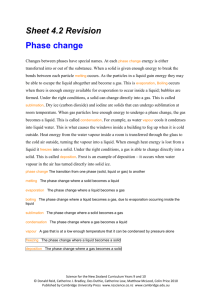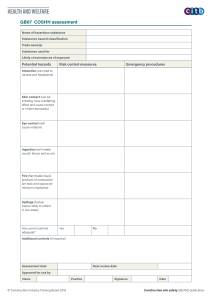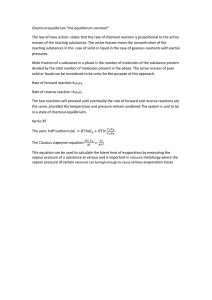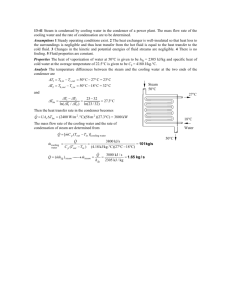Industrial Energy Saving Examples: Condensate, Cooling, Brewery
advertisement
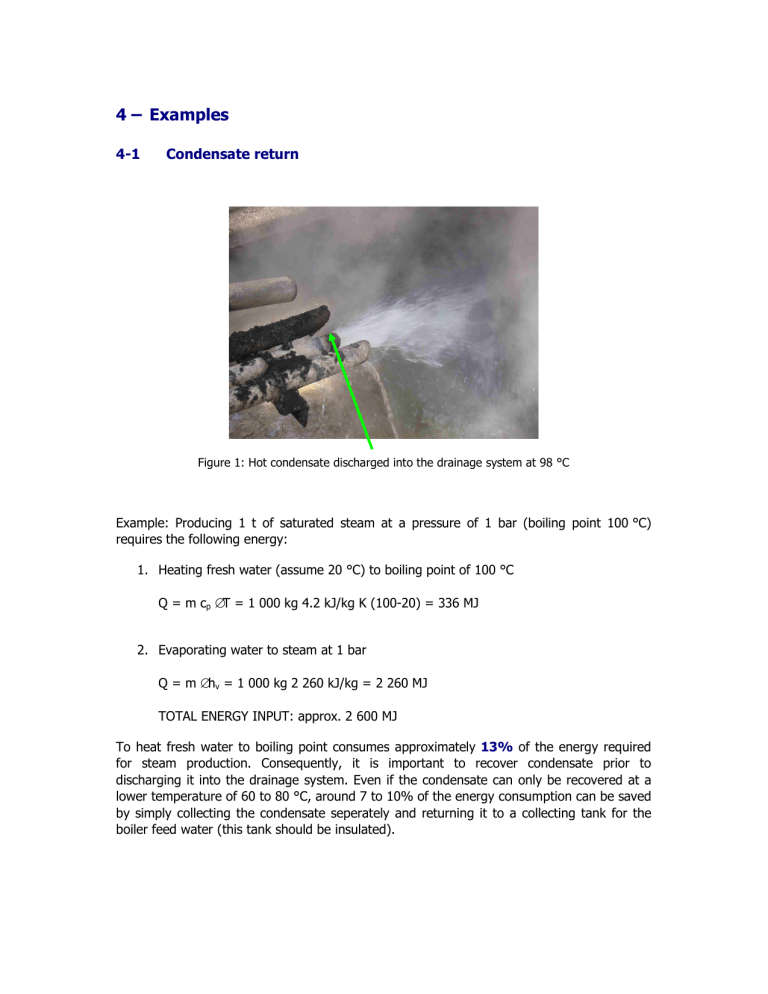
4 – Examples 4-1 Condensate return Figure 1: Hot condensate discharged into the drainage system at 98 °C Example: Producing 1 t of saturated steam at a pressure of 1 bar (boiling point 100 °C) requires the following energy: 1. Heating fresh water (assume 20 °C) to boiling point of 100 °C Q = m cp ∆T = 1 000 kg 4.2 kJ/kg K (100-20) = 336 MJ 2. Evaporating water to steam at 1 bar Q = m ∆hv = 1 000 kg 2 260 kJ/kg = 2 260 MJ TOTAL ENERGY INPUT: approx. 2 600 MJ To heat fresh water to boiling point consumes approximately 13% of the energy required for steam production. Consequently, it is important to recover condensate prior to discharging it into the drainage system. Even if the condensate can only be recovered at a lower temperature of 60 to 80 °C, around 7 to 10% of the energy consumption can be saved by simply collecting the condensate seperately and returning it to a collecting tank for the boiler feed water (this tank should be insulated). 4-2 Cooling The principle of a cooling process is shown in the following diagram. In the cooling area, the cooling agent/refrigerant is evaporated. In this way, heat is removed and a room or a product is cooled. Then the cooling agent/refrigerant is piped into a compressor where pressure and temperature are increased. In the condenser all the heat (from the evaporation Qo and the effect of the compressor) needs to be removed at the temperature Tu. Slides 4 – Energy analysis Cooling process P Qu = Qo + P M Comp ressor Qo Evapora tor Qu Condense r To Tu Collector Low pressure High pressure Efficiency = Q o / P = To / (Tu – To) Figure 2: Cooling process The textbook suggests measures for improving the cooling system. Before considering technological improvement, such as changing the cooling cycle, changing the refrigerant, increasing the insulation of the walls, roof and bottom, heat recovery and so on, organizational and good housekeeping measures should be analysed. Are the actual temperatures adjusted to demand? Each degree of temperature more or less makes a difference. Are cooling facility and amount of cooled product in a reasonable ratio? Figure 3: Ice layer on the evaporator Figure 4: Cooled product versus cooling chamber size Ice layers on the evaporator reduce the heat transfer, the cooling agent operates at a slightly lower temperature, which has a negative effect on the efficiency of the cooling cycle. The following example illustrates the process of heat recovery in the kitchen and cantine of a big company. The kitchen operates several cooling chambers. The cooling cycle is shown below. In this specific case, the refrigerant produces ice water in the evaporator. This ice water is then piped to the cooling chambers, where it is used and piped back to the evaporator (plate-to-plate heat-exchanger in the photo). In the air-cooled condenser, the heat is removed. Warm air at a temperature of 35 to 40 °C leaves the condenser. As an additional advantage, this solution requires a small amount of refrigerant in the cycle as the necessary pipes are very short. Slides 4- Energy analysis Heat recovery cooling units -1 Air-cooled condenser Water-cooled condenser Evaporator Compressor Figure 5: Heat recovery For the modified process, a second small water-cooled condenser – again with a plate-toplate heat exchanger – is installed. The energy (Qo and P) removed in the condenser is used for heating cold fresh water. This water, which can have a temperature of up to 45 °C, is then stored and used as hot water for several purposes in the kitchen (cleaning, dish washing, etc.). Only if water of a higher temperature is needed, sometimes up to 60 °C, the difference is heated by electricity or gas. If there is sufficient hot water, the system switches to the air-cooled condenser. Experience has shown that after the introduction of a heat recovery system hardly any additional energy for hot water production is consumed. 4-3 Energy saving in a brewery The following graph shows the specific heat demand in kWh/hl of beer over several years for a brewery with an annual production of more than 1 million hl. Specific heat consumption of a brewery 50.00 in kWh/hl 40.00 30.00 20.00 10.00 0.00 spec. heat 1993 1994 1995 1996 1997 1998 1999 2000 2001 2002 38.60 40.67 47.30 42.62 41.42 37.56 34.19 29.91 27.58 24.47 Figure 6: Specific heat consumption of a brewery The recorded reduction was, among others, achieved by the following measures: Vapour compression in the brewing process; Cold filtering/pasteurization; Optimization of the heating cycle; Heat/power cogeneration; Improved control of air ventilators. Slides 4- Energy analysis ECOPROFIT-company: Brewery > 1 million hl, ISO 14 000 Saving of water, energy and chemicals due to CP options: Cold filtering/sterilization New filling line Heat/power cogeneration Vapour compression ... Figure 7: Cold filter process In this brewery, a new technology for the pasteurization of beer was introduced. Before, the beer was filled in bottles and then heated to a temperature of 70 °C consuming energy for steam generation. Moreover, after the pasteurization process, the bottles had to be cooled down with water. With the new technology, the beer is piped through a cold filter directly before filling. This cold pasteurization process uses a specially invented and patented membrane filter that removes all the particles which might cause quality problems. This new technology not only saves energy but, in addition, the beer has a better taste because it has not been heated after filling. It is necessary, however, to apply particularly high hygienic standards during production. During the brewing process, wort is heated and partly evaporated by means of hot water and/or steam. The so-called vapour compression is a technology with higher energy efficiency. The vapours from the brewing process are collected and piped to a compressor. The compressor mechanically increases the pressure and temperature of the vapours, which can then be used for heating the brewing process. This solution presents the advantage that the heat of the vapours is utilized. Except for the start-up phase of the brewing process, no additional heat is required. However, additional electricity is consumed for the operation of the compressor (for the principle, see Example 45). Figure 8: Vapour compression unit The optimization of the heating cycle includes the following measures: Setting up individual heating cycles and switching off whole cycles at weekends; Outdoor temperature control; Control of the heating cycle temperature; Switching off/reduction of heating equipment at weekends. In the heat/power cogeneration process implemented in this company, natural gas is burnt in an engine which is connected to a generator for electricity production. The hot exhaust gases of the engine heat the water to a temperature of around 95 °C which is then used in the brewing process. The overall efficiency of a heat/power cogeneration unit with a gas or diesel engine amounts to approximately 80 – 84% (30 – 40% electricity production). Heat/power cogeneration is particularly advantageous, if electricity and heat demand occur at the same time. Figure 9: Heat/power cogeneration – gas engine 4-4 Heat recovery from an air compressor Only 10 to 20% of the compressor output is converted into pressure for compressed air, the remaining 80 to 90% is transformed into heat, which has to be removed by the cooling system. Compressors are in most cases cooled by air, either directly or indirectly by cooling water, which needs to be back-cooled. In the following example, a company decided to install an additional plate-to-plate heat exchanger (see Figure 10). Figure 10: Additional plat-to-plate heat exchanger With this heat exchanger the hot cooling oil can alternatively be back-cooled with water producing hot water at a temperature of 40 to 45°C which is stored and later used in production. The 50 kW compressor is running for approximately eight hours per day at full load. If 80% of the electricity input is deducted for cooling, 8 hours x 50 kW x 80% = 320 kWh or 32 to 40 l of oil per day. This amounts to an annual saving of approximately 12 000 l of oil (300 production days) or approximately USD 5 000. In this specific case, this equals around 4% of the total oil consumption of the company. The investments into the additional heat exchanger, the piping and the reuse of an already existing storage tank were amortized after one year. 4-5 Evaporation: Multistage and vapour compression Evaporation is an energy intensive process step and applied in several sectors, specifically in the food industry. To evaporate 1 kg of water 1.1 kg of steam is required, if the evaporation is carried out in a single step. In the sugar industry, for instance, it is necessary to concentrate the clarified sugar juice (from cane or beets) and to raise the content of dry solids from 12 – 16% to 68 – 72%. Therefore a lot of water has to be evaporated. To reduce the high energy consumption the water is evaporated in a multistage procedure, during which several evaporators are operated in sequence. The vapour generated by the first evaporator is used as “steam” for the second evaporator, and so on. For this system the pressure and temperature in each evaporator has to be lower than in the previous one. A schematic flow is shown in Figure 11 on the next page. The average steam consumption for multistage evaporation is listed in the following table. From the fifth stage onwards, the additional energy savings are not that high any more, therefore the economic impact of the energy saving measures has to be weighed against the higher investment costs for the equipment. Steam consumption to evaporate 1 kg of water In kg of steam Single-stage evaporation 1.1 kg Two-stage evaporation 0.57 kg Three-stage evaporation 0.4 kg Four-stage evaporation 0.3 kg Five-stage evaporation 0.27 kg Theoretical: Practical: n-stages 1/n specific energy consumption 10 to 30% higher In the sugar industry, for example, the evaporation process is carried out in three to six stages, the majority of companies use four and five stages. In addition, the vapour generated during one or several evaporation stages can be used for other purposes, for instance, for preheating juice. Slides 4- Energy analysis Multistage evaporation 1. evaporator 2. evaporator 1. vapour 3. evaporator 2. vapour condenser 3. vapour vacuum pump feed steam 1. concentrate final concentrate 2. concentrate steam condensate 1. vapour condensate 2. vapour condensate 3. vapour condensate Source: Ignatowitz 1994 Figure 11: Multistage evaporation Another example for saving energy during evaporation is the use of a vapour compression unit. At the beginning, the feed solution is heated with steam. Once the feed is boiling, the produced vapour is piped to a compressor, where the pressure is increased to obtain a temperature which is approximately 10 K higher than the boiling temperature of the feed solution. The vapour is then used as “steam” in the evaporator. In a stationary state no additional steam is required. The energy consumption of the unit corresponds to the electricity used by the compressor motor. As an example this vapour compressor is used in the brewing house of a brewery (see Example 4-3). Slides 4- Energy analysis Evaporation by vapour compression evaporator vapour preheated feed pre-heater steam (start-up) compressor vapourcondensate feed solution concentrate Source: Ignatowitz 1994 Figure 12: Evaporation by vapour compression


